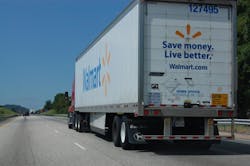The continuing impact of e-commerce on logistics, trucking, and everything else
Craig Menear, chairman, CEO and president of The Home Depot retail chain, recently made an interesting observation about how e-commerce is changing the purchasing process for consumer goods – and that encompasses ALL consumer goods, by the by, from books and knickknacks to appliances and furniture.
“In many, many categories the shopping experience starts in the digital world even though it might finish in the physical world or in some cases actually finish in the digital world as well,” he explained during the company’s second quarter earnings conference call.
“It is truly a blended experience today where the customer, the front door of our store is no longer at the front door of our physical store for many, many product categories,” Menear stressed.
“The customer starts digitally looking at product, doing research and then in many cases particularly in large ticket they come in and they actually want to talk to one of our associates before they make a purchase, but we clearly in big-ticket categories we sell both in the physical and the digital world,” he pointed out.
Indeed, Menear noted that Home Depot’s “dotcom business” represented 6.4% of its overall sales in the second quarter this year and grew approximately 23%.
“Our digital team continues to invest in contents, side improvement and better mobile experiences to take the friction out of the interconnected experience online, while our operations team remains focused on improving the ‘inter-connected’ experience in our stores,” he added.Douglas McMillon, president and CEO of Walmart, noted a similar shift in the consumer buying process during his company’s second quarter call as well.
“In e-commerce, [our] customers are responding favorably to our expanded assortment, which surpassed 67 million SKUs [store keeping units] on walmart.com,” he explained – and that includes its online grocery service, too, which is now in more than 900 U.S. Walmart locations and is being expanded to other global markets.
“Our strategy is to make every day easier for busy families. To accomplish this, we continue our transformation to become more of a digital enterprise that moves with speed and agility,” McMillon said. “Retail is constantly evolving and it’s critical that we move even faster as the customer and competitive landscape continue to change.”
Yet there is far more to that “evolution” than just the change in buying habits, noted Thom Albrecht during TMW Systems and PeopleNet’s 2017 in.sight user conference and exposition in Nashville, TN, last week.
A long-time Wall Street analyst who is now president of his own consulting firm – Sword & Sea Transport Advisors – Albrecht said he’s “spending a lot of time studying the impact of e-commerce” on logistics and transportation and what he’s finding is a lot of major disruption is occurring.
[He made a similar point far more forcefully at the annual Transplace Shipper Symposium back in May.]
“This is a story as old as capitalism itself,” he noted. “Look at what happened in the early part of the 20th century: in 15 short years, the horse and buggy got displaced by the automobile. The same thing happened in the 1940s when we shifted from the icebox to the refrigerator.”
Then there was the changeover to digital photography that destroyed Kodak, which actually invented digital photography. A similar example occurred in 2004 when Netflix tried to get movie and game rental giant to buy it for $50 million.
Blockbuster laughed Netflix out the room, Albrecht said – and then ended up filing for Chapter 11 bankruptcy just six years later, one of them nay victims of the shift to digital movie streaming.
“Disruption is when an entire way of business is upended – and that’s happening now with e-commerce,” he stressed. “In 2013 e-commerce exploded in a way it hadn’t done before and now that ‘flywheel’ is spinning, affecting department stores and shopping malls. Some 5,300 retail stores have closed so far in 2017 and now we’re talking about turning malls into distribution and fulfillment centers, data hubs, or even just bulldozing them.”
Albrecht made another interesting observation where retail shopping is concerned – that era of “free labor” is now over.
“We’ve been driving to the stores for goods and groceries, picking what we want off the shelves, packing them up, and then driving them back to our homes,” he explained. “Now we’re going to expect the stores to do that for us. We’re in the process of flipping that around. Oh, and we don’t want to pay for it either.”
Albrecht added that as consumers become more comfortable with this “digital” way of doing business, more stuff will be brought into the electronic sphere – causing even more disruption.
Take automobiles, for example. If you don’t need to drive to the mall or grocery store to purchase goods, why do you need car? Indeed, Albrecht pointed out that in 2014, only 69% of 19 year olds had driver’s licenses, whereas back in 1983, 94% had them.
“And as autonomous vehicles take hold, we’ll start seeing this shift to ‘Transport as a Service’ or ‘TaaS’ where no one will need to drive at all,” he added. “As a result, there’s a belief out there that automotive sales could fall to under 5 million units annually by 2030.”
Whoa – that would be a HUGE and not-so-positive change, to put it mildly, considering that annual light vehicle sales in the U.S. alone have totaled just under 17 million units annually these last few years.
That’s but one more reason why trucking will need to closely monitor the level of disruption e-commerce is delivering to the freight world.





